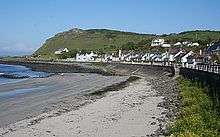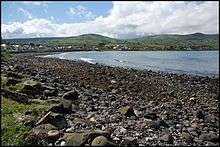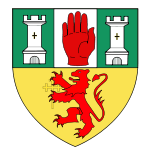Ballygally
Ballygally or Ballygalley (from Irish: Baile Geithligh, meaning "Geithleach's townland") is a village and holiday resort in County Antrim, Northern Ireland which lies on the Antrim coast, approximately 3 miles (5 kilometres) north of Larne. It is also a townland of 769 acres (311 hectares) and is situated in the civil parish of Carncastle and the historic barony of Glenarm Upper.[1] It had a population of 821 in the 2011 Census. It is located within the Mid and East Antrim Borough Council area.
Ballygally | |
|---|---|
Irish village | |
 | |
| Coordinates: 54°53′58″N 5°51′39″W |


Archaeology
In the 1990s archaeological excavations were carried out in Ballygally and remains of a number of Neolithic houses on low ground about 500m from the shore of Ballygally Bay were discovered. Ballygalley Neolithic site produced a large number of finds, including pottery, worked flints and stone axes and is an important Neolithic site.[2]
Places of interest
Notable features include the distinct headland of Ballygally Head, O'Haloran's Castle, The White Bear Rock, a lovely sandy beach, Ballygally Castle and Ballygally Hall, which opened in 2011.
Ballygally beach is a popular destination for locals and tourists alike especially during the summer months.
Ballygally Castle, reputed to be the oldest occupied building in Ireland, has a reputation for being haunted. It sits in the middle of the village at the junction with the road to Cairncastle and contains a 4-star hotel with renovated bar and restaurant. The castle was built around 1625 for James Shaw of Greenock and is one of Ireland's best-preserved Scottish baronial style plantation houses.

The bawn and walled garden are registered as Scheduled Historic Monuments at grid ref: D3725 0781.[3]
Ballygally Hall is a two-storey building (funded by the Big Lottery, Larne Borough Council and NER) which opened in 2011 and includes a Spar shop with some Post Office facilities at ground level and a Community Hall on the first floor. The shop and restaurant, which previously existed on this site, were demolished in 2008, The Community Hall has weekly events and social activities throughout the year.
Cairndhu Golf Course, on top of Ballygally Head, overlooks the village and Carnfunnock Country Park (which offers a cafe, walled garden, caravan park and campsite, maze, children's playground, bouncy castle, mini-train rides, bungee runs, mini-golf, nature walks and lots more family fun) is nearby.
In 2014, Outdoor Recreation NI produced a report called 'Options to enhance access with the creation of a natural heritage trail between Ballygally Village and Carnfunnock Country Park' highlighting Ballygally's close links to the park. [4]
Demography
Ballygally is classified as a small village or hamlet by the NI Statistics and Research Agency (NISRA) (i.e. with a population between 500 and 1,000 people). On Census day (29 April 2001) there were 714 people living in Ballygally. Of these:
- 21.6% were aged under 16 and 22.1% were aged 60 and over
- 49.0% of the population were male and 51.0% were female;
- 27.9% were from a Catholic background and 70.5% were from a Protestant background
- 2.3% of people aged 16–74 were unemployed.

For more details see: NI Neighbourhood Information Service
Biology
Ballygally Head was (in 1983) the only recorded location of Gelidiella calcicola from Northern Ireland.[5]
Geology
Ballygally Head is a volcanic plug, the ancient cooled remains of the pipe of a volcano.[6]
Wedges of agglomerate have been found around Ballygally Head, showing that there were several stages of eruption, allowing tuff to form before the vent was blown out and once more filled with magma.[6] There are tall columns in places around Ballygally Head, similar to the basalt columns found at the Giant's Causeway, but these are dolerite, a rock similar to basalt but which cooled more slowly, held inside the volcano vent, and so had time to grow larger crystals.[7]
Scawt Hill, another volcanic plug 5 km west north west of Ballygally, is an internationally important site for geology due to the rare minerals found there. It is a protected Area of Special Scientific Interest.
References
- "Ballygalley". IreAtlas Townlands Database. Retrieved 21 April 2015.
- O'Sullivan, Aidan & Breen, Colin (2007). Maritime Ireland. An Archaeology of Coastal Communities. Stroud: Tempus. p. 65. ISBN 978-0-7524-2509-2.
- "Ballygalley" (PDF). Scheduled Historic Monuments (2015). Northern Ireland Environment Agency. Archived from the original (PDF) on 27 April 2015. Retrieved 21 April 2015.
- "Report on Access links between Ballygally and Carnfunnock" (PDF). Outdoor Recreation NI. Retrieved 5 December 2015.
- Maggs, C.A. and Guiry, M.D. 1987. Gelidiella calcicola sp. nov. (Rhodophyta) from the British Isles and Northern France. Br. phycol. J. 22: 417 - 434. (Ref. Maggs, C.A. and Guiry, M.D. 1987)
- Wilson, H E et al (1986) Geological Survey of Northern Ireland, HMSO
- Geography in Action, Dolerite, Northern Ireland
